
| Photos Continued from previous page From Wyoming Tales and Trails This Page: Fires. |
 |

| Photos Continued from previous page From Wyoming Tales and Trails This Page: Fires. |
 |
|
|
|
About This Site |
As indicated on the previous page, Truman Everts in his account of his wandering lost in Yellowstone described having to flee a forest fire. He described the fire: The grandeur of the burning forest surpasses description. An immense sheet of flame, following to their tops the lofty trees of an almost impenetrable pine forest, leaping madly from top to top, and sending thousands of forked tongues a hundred feet or more athwart the midnight darkness, lighting up with lurid gloom and glare the surrounding scenery of lake and mountains, fills the beholder with mingled feelings of awe and astonishment. I never before saw anything so terribly beautiful. It was marvelous to witness the flash-like rapidity with which the flames would mount the loftiest trees. The roaring, cracking, crashing, and snapping of falling limbs and burning foliage was deafening. On, on, on traveled the destructive element, until it seemed as if the whole forest was enveloped in flame. Afar up the wood-crowned hill, the overtopping trees shot forth pinnacles and walls and streamers of arrowy fire. The entire hill-side was an ocean of glowing and surging fiery billows. Favored by the gale, the conflagration spread with lighting swiftness over an illimitable extent of country, filling the atmosphere with driving clouds of suffocating fume, and leaving a broad and blackened trail of spectral trunks shorn of limbs and foliage, smoking and burning to mark the immense sweep of its devastation.
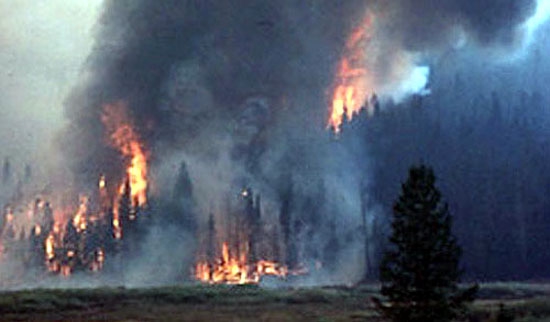 1988 Yellowstone Fire The fires of 1988 bring to mind scenes of blackened destruction. But fires in Yellowstone are a regularly recurring natural event. The Peterson, Washburn, and Hayden Expeditions of 1869, 1870, 1872, and 1878 each reported fires and previously burned areas.
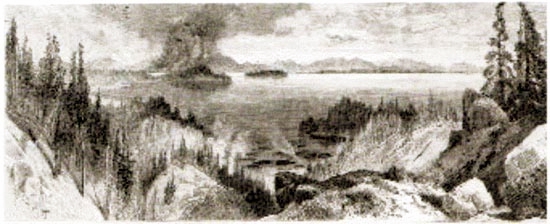 Yellowstone across Lake Yellowstone, 1872. Woodcut based on sketch by Thomas Moran. William Henry Jackson on the Hayden Expedition of 1878 took one of the very first photographs of Jackson Hole. The photo showed the aftermath of a fire.
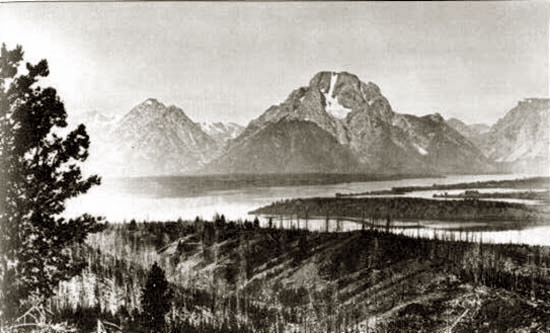 View from Signal Mountain, south of Yellowstone, photo by Wm. H. Jackson. Note the smoke to the left in the above photo. Soils testing reflects that major fires even larger than the 1988 fire have ocurred every 250 to 400 years. 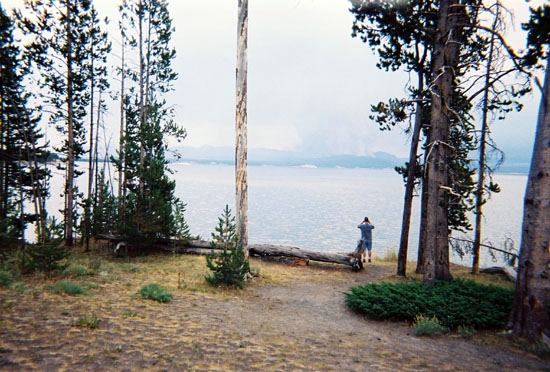 Smoke from Sylvan Pass fire of August 2003 viewed from across Lake Yellowstone, photo by Geoff Dobson
For 100 years from 1872 to 1972, the policy of the government was to fight all fires in Yellowstone. The first Park Superintendent, Nathaniel P. Langford, in a report blamed the fires on tourists and began the policy of fire surpression: It is especially recommended that a law be passed, punishing, by fine and imprisonment, all persons who leave any fire they may have made, for convenience or otherwise, unextinguished. Nearly all extensive conflagrations of timber in the mountains may be directly traced to negligence in extinguishing camp-fires. In the timber regions, these fires are generally kindled against stumps and dry trunks of trees, by which, unless carefully extinguished, they often, after many days, communicate with the forest, and spread over immense tracts, destroying large quantities of valuable timber. Nothing less than a stringent law punishing negligence and carelessness, can save the extensive pine timber fields of the park from destruction. In actuality the bulk of fires in 1988 were caused by lightning. The policy of extinquishing forest fires, however, is now believed to have had a detrimental impact. It caused flamable debris to build up on the forest floor making the fires worse. In Yellowstone the dry climate and winter cold preclude natural rotting of the debris. Fire aids in returning the nutriments to the ground. Additionally, without fire, the area would eventually become an old lodgepole forest. Fire creates meadows and permits a diversity of vegetation as the meadows give way to aspen and the aspen gives way to lodgepole. Not all fires are created by lightning. Truman Everts, himself created one of the two forest fires he encountered, with, however, an unexpected benefit. Everts wrote:
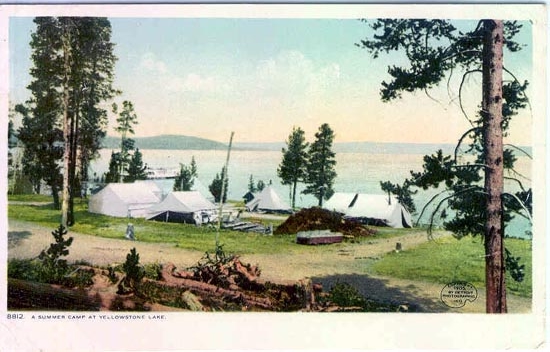 Summer Camp at Lake Yellowstone, Detroit Photographic Company, 1905. Next page: Yellowstone Continued, Bear.
|

